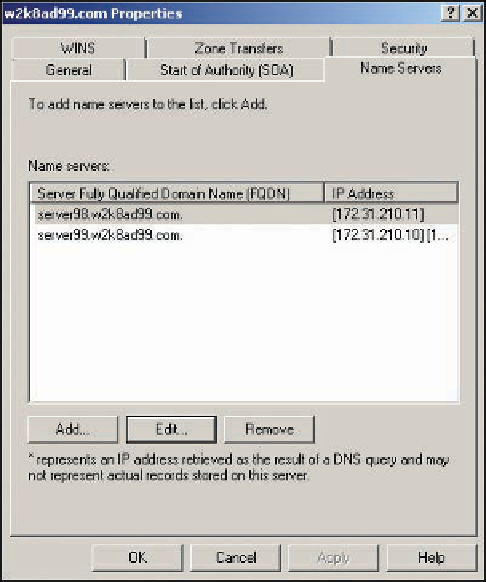Information Technology Reference
In-Depth Information
•
Minimum (default) TTL
—This setting specifies a default TTL value for zone data when
a TTL isn't supplied. The TTL value tells other DNS servers that cache records from this
zone how long to keep cached data and should be adjusted according to how often data in
the zone is likely to change. For example, a zone that maintains only static entries for
resources that aren't changed, added, or removed often can specify a high TTL value. If a
zone maintains dynamic records or records for resources that are going online and offline
constantly, this value should be lower. If a redesign of your network will cause many
changes to zone data, this value can be lowered temporarily. Then wait until the previous
TTL time has elapsed before making the changes. This way, servers caching records that
will be changed don't store them very long. The TTL set on resource records overrides this
default value, which is 1 hour.
NS records specify FQDNs and IP addresses of authoritative servers for a zone. A typical con-
figuration with Active Directory-integrated zones has an NS record for each domain controller
configured as a DNS server in the domain or forest, depending on the scope of zone replication.
NS records are also used to refer DNS queries to a name server that has been delegated
authority for a subdomain. For example, com TLD servers refer queries for resources in the tech-
net.microsoft.com subdomain to a DNS server that's authoritative for the microsoft.com
domain. The microsoft.com domain name server can then refer the query to another DNS server
that has been delegated authority for the technet subdomain of microsoft.com. Subdomains need
not be delegated; they can simply be created under the zone representing their parent domain. If
the subdomain has many resources and traffic on it is heavy, however, zone delegation (explained
in more detail in the next section) is a wise approach.
An NS record technically consists of just the name server's FQDN, but for the name to be
useful, there must be a way to resolve it to an IP address. DNS does this with a
glue A record
,
which is an A record containing the name server's IP address. In DNS Manager, glue records are
created automatically, if possible, by a DNS lookup on the NS record's FQDN; they don't appear
as an A record anywhere in the zone database. Figure 9-13 shows the interface for creating and
Figure 9-13
The Name Servers tab


Search WWH ::

Custom Search